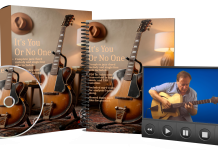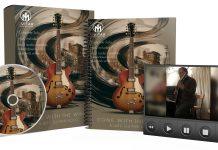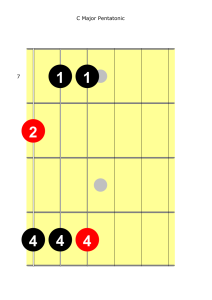This post may contain affiliate links. As an Amazon associate, Google associate as well as associate for other programs, Guitar & Music Institute may earn commissions from qualifying purchases.

Welcome to our comprehensive guide on guitar scales for beginners. Whether you’re just starting out or looking to build upon your existing skills, mastering guitar scales is essential for your musical journey. In this article, we’ll explore the basics of guitar scales, the importance of practicing them, and introduce some essential scales for beginners.
Learning guitar scales can greatly enhance your playing ability. By practicing scales, you’ll develop finger strength and dexterity, become more familiar with the notes on your fretboard, and gain the foundation needed to create beautiful melodies. With dedication and consistent practice, you’ll soon be able to effortlessly navigate the guitar fretboard.
Beginner guitar scales are designed to help you start off on the right foot. We’ll introduce you to some easy guitar scales for beginners, such as the E minor pentatonic scale and the A minor pentatonic scale. These scales only contain a few notes and can be played across open strings and specific frets, making them perfect for beginners to grasp.
To make your learning process even more efficient, we’ll provide you with fretboard diagrams, allowing you to visualize finger placement accurately. This visual aid will ensure that you are playing the correct notes and help you progress faster.
At GMI Guitar Shop, we offer a wide range of free and paid guitar books and downloads to support your learning journey. Whether you’re seeking beginner guitar lessons, learning techniques, or searching for introductory guitar scales, we have the resources you need to succeed.
Key Takeaways:
- Mastering guitar scales is essential for beginners to develop finger strength, dexterity, and familiarity with the fretboard.
- E minor pentatonic and A minor pentatonic scales are great starting points for beginners.
- Using fretboard diagrams can help beginners accurately place their fingers on the guitar.
- Practice regularly and use resources like books and downloads to enhance your learning experience.
- With dedication and persistence, you can master guitar scales and improve your playing ability.
What is a Guitar Scale?
Guitar scales are organized sequences of notes played in an ascending or descending order. They help build finger strength and dexterity, making you more familiar with the notes on your fretboard and providing a framework for creating melodies.
Practicing guitar scales is essential for beginners to develop their skills and improve their playing ability. By incorporating scales into your practice routine, you can enhance your finger strength and dexterity, which will help you play more complex guitar pieces.
Moreover, scales introduce you to different combinations of notes and patterns on the fretboard, allowing you to become more familiar with the instrument and navigate it more effortlessly. This familiarity with notes and the fretboard is crucial for creating melodies, improvising, and composing your own music.
Scales serve as a foundation for understanding music theory and composition. By mastering scales, you gain a deeper understanding of how music is structured and how different notes interact with each other.
So, whether you are a beginner or an experienced guitarist, incorporating guitar scales into your practice routine is essential for developing your skills, improving your finger strength and dexterity, becoming familiar with notes on the fretboard, and creating beautiful melodies.
How to Play Common Guitar Scales
As a beginner guitarist, it is important to learn and practice common guitar scales to enhance your playing skills. These essential scales for beginners will not only help you develop finger strength and dexterity but also improve your familiarity with the fretboard. To ensure accurate finger placement, it is crucial to utilize fretboard diagrams while practicing these scales.
Common Guitar Scales for Beginners
There are several common guitar scales that every beginner should learn:
- E minor pentatonic scale
- A minor pentatonic scale
- C major scale
- G major scale
- E harmonic minor scale
Each scale has its own unique fingering pattern that can be played across different positions on the fretboard. By mastering these common guitar scales, you will be able to expand your musical repertoire and play a variety of songs with ease.
To help you visualize and understand these scales better, here is a fretboard diagram depicting the E minor pentatonic scale:
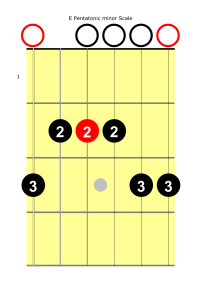
Practice these scales regularly, using the provided fretboard diagrams as a guide. Take your time to memorize the finger placements and gradually increase your speed and accuracy. With consistent practice, you will soon become comfortable playing these essential guitar scales for beginners.
The Pentatonic Scale
The pentatonic scale is a fundamental concept in music theory, particularly in rock and blues genres. It is a versatile five-note scale that forms the foundation of countless riffs, solos, and melodies. Both the major and minor pentatonic scales are widely used in various musical contexts.
The Major Pentatonic Scale
The major pentatonic scale is derived from the major scale by removing the fourth and seventh degrees. This results in a set of five notes that create a bright and uplifting sound. It is commonly used in rock music to craft memorable guitar solos and catchy melodies. Here is a diagram of the major pentatonic scale in the key of C:

| Note | Fret |
|---|---|
| C – string 6 | 8 |
| D – string 6 | 10 |
| E – string 5 | 7 |
| G – string 5 | 10 |
| A – string 4 | 7 |
The Minor Pentatonic Scale
The minor pentatonic scale is derived from the natural minor scale by removing the second and sixth degrees. This scale has a bluesy and soulful sound, making it an essential tool for guitarists in blues music. Here is a diagram of the minor pentatonic scale in the key of A:

| Note | Fret |
|---|---|
| A – string 6 | 5 |
| C – string 6 | 8 |
| D – string 5 | 5 |
| E – string 5 | 7 |
| G – string 4 | 5 |
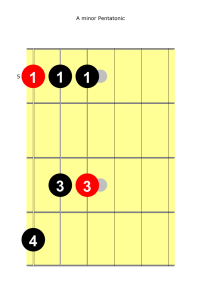
The pentatonic scale is an excellent choice for beginners because it only consists of five notes, making it easier to memorize and navigate on the guitar fretboard. Additionally, its versatility allows you to explore different musical genres and adapt to diverse playing styles. Incorporate the pentatonic scale into your practice routine to develop your musical vocabulary and enhance your improvisation skills.
The Major Scale
The major scale is a fundamental seven-note scale widely used in music theory and composition. It serves as the backbone for countless songs and melodies, making it an essential scale for any aspiring musician. Learning and understanding the major scale is vital for grasping key relationships and developing skills in musical composition.
One popular major scale for beginners to start with is the C major scale. This scale contains no sharps or flats, making it relatively simple to comprehend and play. The C major scale is often one of the first scales taught to beginners due to its straightforward pattern and the absence of accidentals.
Another significant major scale to learn is the G major scale. Unlike the C major scale, the G major scale features one sharp note, which should be duly noted while practicing. Familiarizing yourself with the G major scale expands your understanding of different scales and key signatures.
Major Scale Fingering
When playing the major scale on your guitar, it’s crucial to employ proper finger placement. Below is the fingering pattern for the C major scale:
| Note | Fret | Finger |
|---|---|---|
| C – string 5 | 3 | 1 (index finger) |
| D – sting 4 | open | 0 (no finger) |
| E – string 4 | 2 | 2 (ring finger) |
| F – string 4 | 3 | 3 (index finger) |
| G – sting 3 | open | 0 (no finger) |
| A – string 3 | 2 | 2 (second finger) |
| B – sting 2 | open | 0 (no finger) |
| C – sting 2 | 1 | 1 (index finger) |
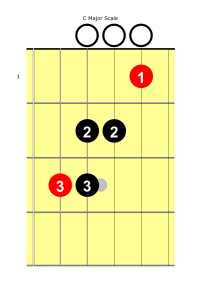
Remember to practice the major scale with a metronome, gradually increasing your speed as you become more comfortable. Incorporate different rhythmic patterns, such as eighth notes and triplets, into your practice routine to further develop your musicality.
Conclusion
Guitar scales are an essential part of your journey to learning and mastering the guitar. As a beginner, incorporating scales into your practice routine can help you develop finger strength and dexterity, improve your understanding of the fretboard, and lay a solid foundation for creating melodies and improvisation.
By dedicating regular practice sessions to mastering guitar scales, you can elevate your playing and take your guitar skills to the next level. Consistency is key – make sure to set aside time each day or week to focus on your scale exercises. With persistence and patience, you’ll see progress and improvement in your playing.
FAQ
What are guitar scales?
Guitar scales are organized sequences of notes played in an ascending or descending order that help you build finger strength and dexterity. They also make you more familiar with the notes on your fretboard and provide a framework for creating melodies.
What are some common guitar scales for beginners?
Some common guitar scales for beginners include the E minor pentatonic scale, A minor pentatonic scale, C major scale, G major scale, and E harmonic minor scale. Each scale has its own unique fingering pattern and can be played across different positions on the fretboard.
How do I play guitar scales?
To play guitar scales, it is important to practice using fretboard diagrams to ensure accurate finger placement. Start by familiarizing yourself with the fingering pattern of the scale and then practice playing it slowly and accurately. Over time, increase the speed and work on playing the scale across different positions on the fretboard.
What is the pentatonic scale?
The pentatonic scale is a popular five-note scale that is commonly used in rock and blues music. It is a versatile scale that can be used for riffs, solos, and melodies. The major pentatonic scale is derived from the major scale, while the minor pentatonic scale is derived from the minor scale.
What is the major scale?
The major scale is a seven-note scale that is commonly used in music theory and composition. It is the basis for many songs and melodies. The C major scale is a popular scale for beginners to learn because it contains no sharps or flats, making it easier to understand and play. The G major scale is another important scale for beginners to learn, as it has one sharp note that should be noted.
Why are guitar scales important for beginners?
Guitar scales are an essential part of learning to play the guitar. They help beginners develop finger strength and dexterity, improve their understanding of the fretboard, and provide a foundation for creating melodies. By practicing and mastering these scales, beginners can elevate their playing and take their guitar skills to the next level.
For more in-depth guidance on guitar scales and techniques, check out our latest free and paid guitar books and downloads at gmiguitarshop.com.
Source Links
- https://www.fender.com/articles/scales/5-essential-guitar-scales-for-beginners
- https://fretello.com/news/2-essential-guitar-scales-for-beginners/
- https://www.guitarmasterclass.net/beginner-guitar/beginner-scales.htm/
This post may contain affiliate links. As an Amazon associate, Google associate as well as associate for other programs, Guitar & Music Institute may earn commissions from qualifying purchases.



